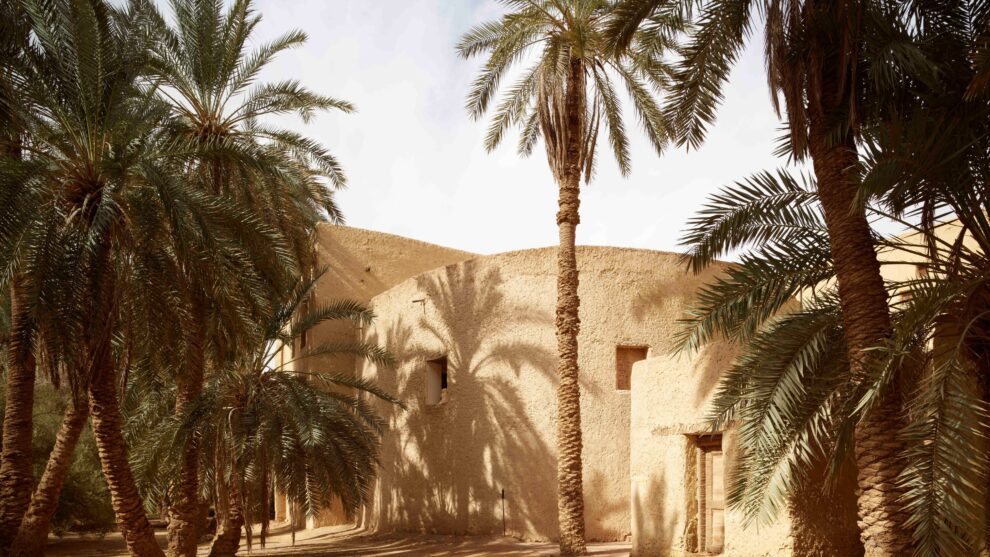A designer and an environmentalist have created a retreat that surrenders to the desert.
WHEN INDIA MAHDAVI first began traveling to Egypt, she was in her late 20s and longing to connect with her ancestral origins. The architect and designer, now 61, was born in Tehran to an Egyptian mother and an Iranian father and grew up mainly in Cambridge, Mass.; Heidelberg, Germany; and Vence, France. “I was feeling like a plant in a pot that had eaten up all its earth,” she says. “I was all roots and no soil, craving for somewhere deeper to be planted.”
In 1999, after frequent trips to Egypt (her mother’s family is from Alexandria), Mahdavi chose to visit Siwa, an urban oasis (population 35,000) on the edge of the Great Sand Sea, a vast expanse of desert near the Libyan border and accessible only by car, bus or charter flight (from Cairo, it’s 90 minutes by plane). Within the oasis are a cluster of psychedelic blue salt lakes, natural springs, date palm plantations and olive trees. For miles in every direction beyond the oasis, there’s little else but sand.

The village of Shali, Siwa’s fortified historic center, dates to the 13th century, when its inhabitants, many of Berber origin, built a settlement out of kershef, a light-colored composite of sand and salt abundant in the region. In 1926 heavy rains nearly destroyed the village, which these days resembles a complex of enormous drip sand castles. A newer town with simple one-story structures built of sandstone and cement sprang up around it, and now houses most of the population, as well as cafes, backpacker inns and small shops selling locally made rugs and crafts.


Mahdavi arrived knowing little of the place. She’d come at the invitation of the Cairo-born environmentalist and businessman Mounir Neamatalla, now 76, a close family friend who was in the middle of an adventure of his own: He was building an ambitious eco-lodge made almost entirely out of kershef, set between a flat-topped mountain and the lake that surrounds it. Mahdavi helped Neamatalla complete the project, which he named Adrère Amellal, from the Berber language Siwi (the phrase translates to “white mountain” in English). With over 40 guest rooms set inside a series of thick-walled buildings the color and texture of old parchment, Adrère Amellal appears to rise up out of the desert like a mirage made of sand. “The radicalness of his project, with no electricity, building with salt and mud, set within a beautiful ancient landscape, was pure magic,” Mahdavi says. Even today, more than two decades after it opened, the lodge is something of a pilgrimage site for architecture fans and the design obsessed.


SINCE THAT INITIAL trip, Mahdavi, who’s now largely based in Paris, has returned to Siwa frequently and, in the mid-aughts, she and Neamatalla began working on another seemingly quixotic project there: a roughly 8,000-square-foot, seven-bedroom fortresslike structure, fashioned out of kershef and clay, with sandstone flooring and a palm wood-clad roof, that would be Neamatalla’s private residence. Neamatalla chose to set it near a barren rock formation in the middle of a palm grove — close to Adrère Amellal but well concealed from the main road so it wouldn’t dominate the landscape.


Named Tamazid after a nearby spring, the compound is, like Adrère Amellal, all earth tones, inside and out. It’s a notable departure for the designer, who’s best known for her inimitable use of color. (She was an originator of what later became known as the millennial pink trend, thanks to the bubble gum-colored interior she designed in 2014 for London’s Gallery restaurant at Sketch, an Instagram staple.) The experience of being on the property is like stepping inside an M.C. Escher print; perspectives and proportions seem to shift, depending on the light or the angle where one stands. Stairs lead to terraces that overlook the compound and surrounding landscape — the blocky structure has few windows, and most of them are different sizes. Inside, straight lines are rare and the kershef surfaces are pleasingly irregular. To Mahdavi, Neamatalla’s approach to Adrère Amellal felt more like sculpting than anything else — “The footprint of a structure was traced on the soil,” she says. “We’d decide where the windows should be according to the views and the sun” — but with Tamazid, she made traditional plans and models. (This was the first building she designed as an architect.) There were occasional disputes: In the middle of construction, she came back after being away for several months to find that Neamatalla had added another wing to the building. Mahdavi insisted it be torn down. In the end, the two reached a compromise and kept part of the addition.


As at Adrère Amellal, the furnishings are inspired by the surroundings. Nearly every object has been designed by Mahdavi and made by artisans from local sandstone, salt or date palm or olive wood. Over the years, she has filled the place with bespoke furnishings suited to the environment, some resembling her signature pieces. “These shapes are part of my vocabulary,” she says, “but they’re adapted to the local materials in collaboration with local makers.”

She and Neamatalla also became increasingly inventive with their design. Built-in benches and bed frames were molded out of limestone. The legs of an outdoor table, carved from limestone, resemble the trunk of a palm tree. Rope, made from date palm fibers, covers the ceilings and window frames. Neamatalla also used rope to create curtains between rooms, to encourage breezes and allow for veiled views. In the absence of colors, Mahdavi says, there are textures: “They create vibrations like colors do when their surfaces reflect the sun or cast shade. It’s all about catching the light.”


In Neamatalla’s bedroom, blocks of rock salt, harvested from Siwa’s lakes, were carved into rectangles that now line the walls, as well as the walls of the lounge that overlooks the courtyard, where they appear as diamond-shaped tiles. “The salt in Siwa is especially white, with beautiful crystals,” says Mahdavi, noting that it has the translucency of alabaster. Like Adrère Amellal, Tamazid doesn’t have electricity. In the evenings, candles are placed in scores of salt votives to provide light, and there’s also the round fire pit made of sandstone on the main terrace. “For centuries, the people who lived here knew that to survive they had to adapt to the environment, rather than forcing the environment to adapt to them,” Neamatalla says. “We can learn so much from that.”
Source : The New York Times











Add Comment